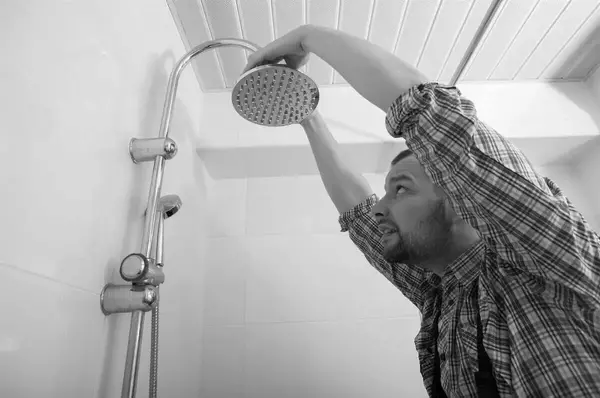As an expert in licensed plumber, I understand the frustration of dealing with a leaking shower arm. It not only wastes water but can also damage your bathroom walls and floors if left unattended. In this blog post, you will learn about the common causes of a leaking shower arm and how to fix it without calling a plumber.
Table of Contents
Understanding the Problem: What is a Shower Arm Leak?
A shower arm leak can be an elusive culprit behind increased water bills and unnecessary waste of precious resources. It typically originates from the shower arm – the conduit that bridges the water source in your wall and your showerhead. This type of leak is frequently a result of a compromised sealant or a worn-out pipe. Its stealthy nature makes it easy to miss until it has done significant damage or increased your water bills noticeably. Thus, understanding what a shower arm leak is can be the key to early identification and efficient resolution.
Identifying the Leak: Spotting the Signs Early
Cracking the code to your shower arm leak begins with the crucial task of pinpointing the issue. This process is akin to solving a mystery; you’re on the lookout for tell-tale signs that point towards the leak. The most evident indicator would be water trickling down from where the shower arm meets the wall or the showerhead. This usually suggests a faulty seal or deteriorated pipe.
But a shower arm leak can also manifest in more subtle ways. You might notice a sudden drop in water pressure during your showers, which could indicate a leak somewhere within the plumbing. Another sign to watch out for is the presence of dampness, mildew, or discoloration around the shower arm area. This usually signals an ongoing leak that’s seeping into the surrounding material. Similarly, if you see water stains on the wall or ceiling directly underneath the shower, it’s likely that you have a leak in the shower arm.
As you embark on this detective-like mission, remember that timing is of the essence. Spotting these signs early could be the difference between a simple DIY fix and an expensive, time-consuming shower repair. So, keep a keen eye on your shower arm and the surrounding areas, and you’ll be well on your way to nipping this leak in the bud.
Preparation: Gathering Your Tools
Before diving headfirst into the leak repair process, it’s imperative to have all the necessary tools and supplies at your disposal. A crucial first step in your DIY journey to resolving a shower arm leak involves an adjustable wrench, which will be your main weapon against this water-wasting culprit. This handy tool will assist in loosening and removing the showerhead, and if need be, the shower arm itself.
Next, you’ll need Teflon tape, more commonly known as plumber’s tape, which is essential in ensuring a tight and leak-free connection between the shower arm and the wall or showerhead. Keep in mind that you may need to replace the shower arm entirely if it’s significantly damaged, so it’s best to have a new one on standby.
Additionally, lay out a towel to safeguard the showerhead once it’s removed, preventing any potential damage. The last thing you want is to inadvertently add ‘buy a new showerhead’ to your to-do list.
Finally, arm yourself with a bucket to collect any residual water during the repair process. This helps maintain a dry and safe workspace, while also preventing any unnecessary mess.
One crucial aspect of your preparation process that can’t be stressed enough is turning off the water supply. It’s a simple step, but one that can prevent a surprising and potentially hazardous water spray during your repair work. By equipping yourself with the proper tools and taking the necessary precautions, you’re setting yourself up for a successful repair of your shower arm leak.
Related Contenet: Walk-in showers
Removing the Showerhead: Taking the First Step
You’re now ready to dive into the actual repair work. Start by using your adjustable wrench to carefully detach the showerhead from the shower arm. This process needs to be done with patience and caution to protect the threads on the arm from any potential damage. Once removed, place your showerhead on the towel you’ve prepared earlier. This acts as a safe cushion, keeping your showerhead safe and undamaged as you proceed with the next steps of your repair.
Inspecting the Shower Arm: Checking for Damage
With the showerhead safely stowed away, direct your focus towards the shower arm. This is your chance to look for any visible signs of deterioration or damage that might be causing the leak. Keep an eye out for any signs of wear and tear, such as visible cracks or chips, which might compromise the integrity of the arm.
Remember, even minor damage can result in significant leakage. If the shower arm appears intact, you can likely proceed with resealing the threads as the solution. However, if you find any signs of damage, you’ll have to replace the entire arm to ensure a thorough and lasting repair. So, carefully scrutinize the shower arm, because what you find here will determine your next course of action in this DIY journey to resolve your shower arm leak.
Related Content: Leaky shower tips
Resealing or Replacing: The Crucial Step
Upon inspection, if the shower arm is in good condition, start by adding new Teflon tape to the threads on both ends. Make sure to follow the direction of the threads while wrapping for an optimal seal. However, if you discovered damage on the arm, it’s time to put that replacement to use. Employ your trusty wrench to gently unscrew the damaged shower arm from the wall, then set it aside.
Afterward, introduce the new shower arm to its place. Here, too, don’t forget to seal the threads with Teflon tape before securing the arm. Regardless of whether you’ve had to replace the arm or not, the application of the Teflon tape is a pivotal part of the process, ensuring that your connection is tight and leak-proof. Following these directions carefully will help secure your success in repairing your shower arm leak.
Reconnecting the Showerhead: The Final Step
With the arm securely in place and sealed, it’s time to bring the showerhead back into the picture. Gently screw it back onto the arm, ensuring you’re turning it in a clockwise direction until it fits snugly. Now comes the moment of truth. Reinstate the water supply and observe the shower arm and the surrounding areas closely for any evidence of leakage.
If you see no traces of water escaping, congratulations! You’ve successfully resolved your shower arm leak. If, however, you notice any dampness, don’t be discouraged. It might just require a bit more Teflon tape or a slightly tighter fit. Don’t be afraid to retrace your steps, adjusting as necessary. After all, the aim of this DIY journey is not just to stop the leak, but to build confidence in your ability to handle household repairs.
FAQs in Relation to How to Fix a Shower arm Leak
How do you fix a leaky shower arm?
To fix a leaky shower arm, the first step is to turn off the water supply. Then, use an adjustable wrench or pliers to loosen and remove the old shower arm from its connection point. Clean any debris from inside of the pipe threads before installing a new one. Make sure that you select a compatible replacement part and then carefully hand-tighten it into place with your wrench or pliers until it is firmly secured in position. Test for leaks by turning on the water supply again and check for any signs of leakage around connections points or other areas of concern.
Why is my shower head leaking at the arm?
The most common cause of a leaking shower head at the arm is due to an improper seal between the shower arm and the pipe. This problem may arise due to erosion, accumulation of debris or deterioration over time. To fix this issue, it is important to first shut off your water supply before attempting any repairs. Once the water is off, unscrew the showerhead from its mount and look for any visible wear or corrosion. If necessary, replace with a new gasket/sealant before reattaching your new showerhead securely onto its connection point using Teflon tape for added protection against leaks in future.
How do I stop my shower pipe from leaking?
To locate the origin of the leak, investigate where it is coming from. If it is coming from a pipe connection, check if any fittings are loose or corroded. Tighten them with an adjustable wrench and replace any damaged parts as needed. If the pipes themselves have been damaged, they may require a full replacement. You should also inspect for signs of water damage around your shower such as discoloration on walls or floors that could indicate a more serious problem than just a leaking pipe. Contact a specialist to evaluate and mend the problem efficiently and securely, preventing any additional harm in your home or business.
How do you seal a shower arm flange?
To seal a shower arm flange, first shut off the water supply and remove the old flange. Clean any debris from inside the pipe with an abrasive cloth or brush. Apply plumber’s putty around the outside of the new flange before inserting it into place. Tighten screws to secure it in place then turn on your water supply to check for leaks. If necessary, apply more putty as needed until there are no leaks present.
Conclusion
Mending a shower arm leak is an uncomplicated, economical job that can be accomplished in less than half an hour. With the right tools, knowledge, and experience you can fix a shower arm leak quickly and efficiently. Be sure to follow these steps closely when attempting to fix your own leaking shower arm: identify the source of the leak; shut off water supply; remove old parts such as washers or gaskets; replace them with new ones; test for leaks once complete. By following this guide you will have successfully fixed your own leaking shower arm.

